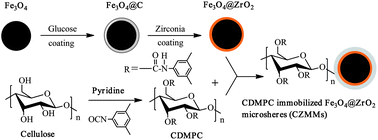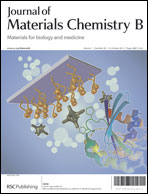Chiral zirconia magnetic microspheres as a new recyclable selector for the discrimination of racemic drugs†
Abstract
Separation of enantiomers of a chiral compound is one of the most interesting and challenging tasks because of their identical physical and chemical properties. Magnetic materials possessing chiral functionality on their surface can not only exhibit magnetic properties but also recognize chirality. Fe3O4@ZrO2 core–shell nano-materials have not been reported previously for chiral separation of racemates. Zirconia has been shown to be the most stable oxide mechanically, thermally and chemically, and shows better physical and chemical properties among inorganic metal oxides. The present work explores core–shell microspheres consisting of a Fe3O4 magnetic core covered by a zirconia shell (Fe3O4@ZrO2) which are immobilized with cellulose tris(3,5-dimethylphenylcarbamate) to get chiral zirconia magnetic microspheres (CZMMs). As-synthesized CZMMs have been applied for the separation of racemic chiral drugs and the results indicate the CZMMs are potential chiral nanomaterials for enantioseparations. Most importantly the synthesized CZMMs have shown an excellent recyclability and can be used for further chiral separations of different kinds of racemates.


 Please wait while we load your content...
Please wait while we load your content...